| Srl | Item |
| 1 |
ID:
130661
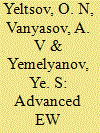

|
|
|
|
|
| Publication |
2014.
|
| Summary/Abstract |
The article discusses advanced reconnaissance and weapon guidance radars as potential targets of electronic warfare. Also discussed are the role and significance of reconnaissance and weapon guidance radar systems in combat operations, and general trends toward greater information gathering capabilities of radar systems. It also presents the multiple input-multiple output (MIMO) multichannel radar system, and the effectiveness and survival rate of radar systems using MIMO technologies.
|
|
|
|
|
|
|
|
|
|
|
|
|
|
|
|
| 2 |
ID:
018063
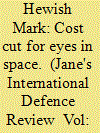

|
|
|
|
|
| Publication |
Dec 2000.
|
| Description |
32-38
|
|
|
|
|
|
|
|
|
|
|
|
|
|
|
|
| 3 |
ID:
131266
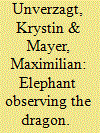

|
|
|
| 4 |
ID:
120658
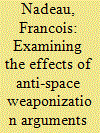

|
|
|
|
|
| Publication |
2013.
|
| Summary/Abstract |
This study examines how political activists are framing the space weaponization debate in Canada and whether their arguments can influence public attitudes and perceptions about the issue. Eighty university students from two undergraduate courses were recruited as participants in a quasi-experiment. One class (n = 38) was exposed to the documentary Masters of Space, an episode of the Canadian Broadcasting Corporation's program The Nature of Things, and another class (n = 42) served as the control group. Pre-test and post-test questionnaires were used to measure the effects of viewing anti-weaponization arguments in the media, while also controlling for the influence of prior beliefs and background characteristics of participants. Results suggest that visually depicting the use of satellite technology in society can convince viewers that satellites are important to their way of life, but not necessarily to the defense of North America. Framing missile defense as a 'space weapon in disguise' also seemed to raise opposition to Canada's participation in continental missile defense. The findings, meanwhile, indicate that viewers respond strongly to the issue of space debris and that mobilizing support for joint military space projects may best be achieved by emphasizing the usefulness of these projects for locating and tracking such debris. In the end, media exposure seemed to help legitimize anti-weaponization arguments based more on rational self-interests than on idealistic beliefs. These findings can have implications for the way space policies are communicated to the public.
|
|
|
|
|
|
|
|
|
|
|
|
|
|
|
|
| 5 |
ID:
052534
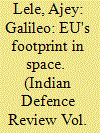

|
|
|
|
|
| Publication |
Apr-Jun 2004.
|
|
|
|
|
|
|
|
|
|
|
|
|
|
|
|
| 6 |
ID:
131027
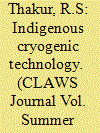

|
|
|
|
|
| Publication |
2014.
|
| Summary/Abstract |
From launching sounding rockets on the Kerala coast in the 19605, to the launch of ten satellites in one go in April 2008, Indian space scientists have indeed come a long way. In fact, this January, taking one more crucial step in space technology has further strengthened their resolve to accomplish other space-related goals. After two decades of the protracted and focussed research and developmental efforts of the Indian Space Research Organisation (ISRO) scientists, it was India's turn to celebrate the glory of its space programme on January 05, 2014, when ISRO's Geosynchronous Satellite Launch Vehicle (GSLV-D5), powered by an indigenously developed cryogenic engine, successfully launched the GSAT- 14, a communication satellite, from Sriharikota
|
|
|
|
|
|
|
|
|
|
|
|
|
|
|
|
| 7 |
ID:
131028
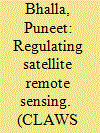

|
|
|
|
|
| Publication |
2014.
|
| Summary/Abstract |
The freedom of operations in space and of remote sensing by satellites has been globally accepted through different UN Conventions. Satellite imaging provides unrestricted access to areas transcending international borders and its commercialisation has resulted in the irrelevance of these borders even for distribution of data as commercial entities seek a larger and more diversi?ed customer base. Availability of such information commercially is enabling and in?uencing worldwide scienti?c, technological, social and economic advancements. However, its dual use potential that could provide disproportionate strategic and military advantages has raised concerns regarding the distribution. Differing interests have made regulating the sector a complex task. Nations that possess the capability want to strike a balance between their national security interests and foreign policy concerns, on the one hand, and commercial interests, on the other. At the same time, all nations remain apprehensive about the distribution of information about their area without their knowledge or consent.
|
|
|
|
|
|
|
|
|
|
|
|
|
|
|
|
| 8 |
ID:
061427
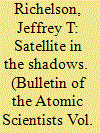

|
|
|
|
|
| Publication |
May-Jun 2005.
|
|
|
|
|
|
|
|
|
|
|
|
|
|
|
|